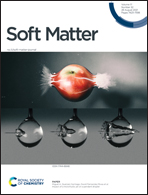Asymmetric desorption of lipid oxidation products induces membrane bending†
Abstract
Lipid oxidation, detected in metabolic processes, is induced in excess when the cellular membrane suffers extra oxidative stress. Lipid oxidation can compromise biomembrane function in part through perturbations of lipid packing, membrane permeability, and morphology. Two major types of oxidation products, one with a partially truncated lipid tail with a hydrophilic group at the tail-end, and secondly, a lysolipid (with one of the chains completely truncated) can disturb the membrane bilayer packing significantly. However, they also have an increased tendency to desorb from the membrane. In this study we investigated desorption kinetics of two characteristic lipid oxidation products (PAzePC and 18 : 1 LysoPC) from a model membrane system, and we evaluated the consequences of this process on membrane shape transitions. Using a microfluidic chamber coupled with micropipette aspiration, we observed the incorporation of the two lipids into the membrane of a giant unilamellar vesicle (GUV) and further determined their desorption rates, association rates and flip-flop rates. For both lipids, the desorption is on the time scale of seconds, one to two orders of magnitude faster than their flipping rates. Dilution of the outer solution of the GUVs allowed asymmetric desorption of these two lipids from the GUVs. This process induced lipid number asymmetry and charge asymmetry, specifically for PAzePC containing GUVs, and caused membrane tubulation. Our results indicate that the desorption of lipid oxidation products can alter the local structure of biomembranes and result in morphological changes that may relate to membrane function.



 Please wait while we load your content...
Please wait while we load your content...